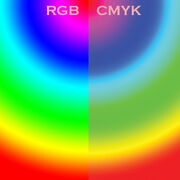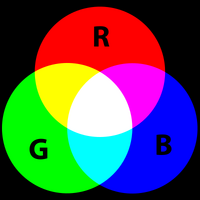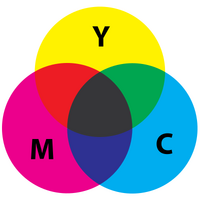Assessment |
Biopsychology |
Comparative |
Cognitive |
Developmental |
Language |
Individual differences |
Personality |
Philosophy |
Social |
Methods |
Statistics |
Clinical |
Educational |
Industrial |
Professional items |
World psychology |
Cognitive Psychology: Attention · Decision making · Learning · Judgement · Memory · Motivation · Perception · Reasoning · Thinking - Cognitive processes Cognition - Outline Index
A color model is an abstract mathematical model describing the way colors can be represented as tuples of numbers, typically as three or four values or color components (e.g. RGB and CMYK are color models). However, a color model with no associated mapping function to an absolute color space is a more or less arbitrary color system with little connection to the requirements of any given application.
Adding a certain mapping function between the color model and a certain reference color space results in a definite "footprint" within the reference color space. This "footprint" is known as a gamut, and, in combination with the color model, defines a new color space. For example, Adobe RGB and sRGB are two different absolute color spaces, both based on the RGB model.
In the most generic sense of the definition above, color spaces can be defined without the use of a color model. These spaces, such as Pantone, are in effect a given set of names or numbers which are defined by the existence of a corresponding set of physical color swatches. This article focuses on the mathematical model concept.
Understanding the concept

A comparison of RGB and CMYK color models.
Most people have heard that a wide range of colors can be created by the primary colors red, blue, and yellow, if working with paints. Those colors then define a color space. We can specify the amount of red color as the X axis, the amount of blue as the Y axis, and the amount of yellow as the Z axis, giving us a three-dimensional space, wherein every possible color has a unique position.
However, this is not the only color space. For instance, when colors are displayed on a computer monitor, they are usually defined in the RGB (red, green and blue) color space. This is another way of making the same colors, and red, green and blue can be considered as the X, Y and Z axes. Another way of making the same colors is to use their hue (X axis), their saturation (Y axis) and their brightness (Z axis). This is called the HSV color space. Many color spaces can be represented as three-dimensional (X,Y,Z) values in this manner, but some have more, or fewer dimensions, and some cannot be represented in this way at all.
Notes
When formally defining a color space, the usual reference standard is the CIELAB or CIEXYZ color spaces, which were specifically designed to encompass all colors the average human can see. This is the most accurate color space but is too complex for everyday uses.
Since "color space" is a more specific term for a certain combination of a color model plus a color mapping function, the term "color space" tends to be used to also identify color models, since identifying a color space automatically identifies the associated color model. Informally, the two terms are often used interchangeably, though this is strictly incorrect. For example, although several specific color spaces are based on the RGB model, there is no such thing as the RGB color space.
Since any color space defines colors as a function of the absolute reference frame, color spaces, along with device profiling, allow reproducible representations of color, in both analogue and digital representations.
Color space density
The RGB color model is implemented in different ways, depending on the capabilities of the system used. By far the most common general-use incarnation as of 2006 is the 24-bit implementation, with 8 bits, or 256 discrete levels of color per channel. Any color space based on such a 24-bit RGB model is thus limited to a gamut of 256×256×256 ≈ 16.7 million colors. Some implementations use 16 bits per component, resulting in the same range with a greater density of distinct colors. This is especially important when working with wide-gamut color spaces (where most of the more common colors are located relatively close together), or when a large number of digital filtering algorithms are used consecutively. The same principle applies for any color spaces based on the same color model, but implemented in different bit depths.
Partial list of color spaces
CIE 1931 XYZ color space is the first attempt to produce a color space based on measurements of human color perception and it is the basis for almost all other color spaces. Variants of the CIE space include
- CIELUV color space - a modification to display color differences more conveniently, replaced by:
- CIELAB color space
- CIE 1964 color space - measurements over a larger field of view than the 1931 color space which produces slightly different results.
Generic color models

Additive color mixing

Subtractive color mixing
RGB uses additive color mixing, because it describes what kind of light needs to be emitted to produce a given color. Light is added together to create form from out of the darkness. RGB stores individual values for red, green and blue. RGBA is RGB with an additional channel, alpha, to indicate transparency.
Common color spaces based on the RGB model include sRGB, Adobe RGB and Adobe Wide Gamut RGB.
CMYK uses subtractive color mixing used in the printing process, because it describes what kind of inks need to be applied so the light reflected from the substrate and through the inks produces a given color. One starts with a white substrate(canvas, page, etc), and uses ink to subtract color from white to create an image. CMYK stores ink values for cyan, magenta, yellow and black. There are many CMYK colorspaces for different sets of inks, substrates, and press characteristics (which change the dot gain or transfer function for each ink and thus change the appearance).
YIQ was formerly used in NTSC (North America, Japan and elsewhere) television broadcasts for historical reasons. This system stores a luminance value with two chrominance values, corresponding approximately to the amounts of blue and red in the color. It corresponds closely to the YUV scheme used in PAL (Australia, Europe, except France, which uses SECAM) television except that the YIQ color space is rotated 33° with respect to the YUV color space. The YDbDr scheme used by SECAM television is rotated in another way.
YPbPr is a scaled version of YUV. It is most commonly seen in its digital form, YCbCr, used widely in video and image compression schemes such as MPEG and JPEG.
xvYCC is a new international digital video color space standard published by the IEC (IEC 61966-2-4). It is based on the ITU BT.601 and BT.709 standards but extends the gamut beyond the R/G/B primaries specified in those standards.
HSV (hue, saturation, value), also known as HSB (hue, saturation, brightness) is often used by artists because it is often more natural to think about a color in terms of hue and saturation than in terms of additive or subtractive color components. HSV is a transformation of an RGB colorspace, and its components and colorimetry are relative to the RGB colorspace from which it was derived.
HSL (hue, saturation, lightness/luminance), also known as HLS or HSI (hue, saturation, intensity) is quite similar to HSV, with "lightness" replacing "brightness". The difference is that the brightness of a pure color is equal to the brightness of white, while the lightness of a pure color is equal to the lightness of a medium gray.
YBR (luminance, normalized red, normalized blue).
Commercial color spaces
Special-purpose color spaces
- The RG Chromaticity space is used in Computer vision applications, and shows the color of light (red, yellow, green etc.), but not its intensity (dark, bright).
Obsolete color spaces
Early color spaces had two components. They largely ignored blue light because the added complexity of a 3-component process provided only a marginal increase in fidelity when compared to the jump from monochrome to 2-component color.
- RG for early Technicolor film
- RGK for early color printing
References
- R. W. G. Hunt, The Reproduction of Colour in Photography, Printing & Television, 5th Ed. Fountain Press, England, 1995. ISBN 0-86343-381-2
- Mark D. Fairchild, Color Appearance Models, Addison-Wesley, Reading, MA (1998). ISBN 0-201-63464-3
- Charles A. Poynton, Introduction to Video Colour Spaces
See also
- List of colors
- Additive color
- Subtractive color
- Color models
- Color theory
- List of color spaces and their uses
External links
- Bruce Lindbloom's equations for color conversion
- Bruce Lindbloom's CIE Color Calculator
- Charles Poynton's Color FAQ
- FAQ about color physics
- Dan Bruton's Color Science
- Color-Scheme - open source color space management package written in Scheme
- Color Space Conversion Formulas
- Color Space Conversion: conceptual understanding for photographers using detailed visualizations
- yaflaColor: HSL-RGB Conversion and exploration
- Color Space Visualization
Color space | |
|---|---|
| List of color spaces · Color models | |
| CIE |
|
| RGB |
color spaces · sRGB · Adobe · Wide Gamut · ProPhoto · scRGB |
| YUV |
YUV (PAL) · YDbDr (SECAM) · YIQ (NTSC) · YCbCr · YPbPr · xvYCC |
| Other |
LMS · HSL, HSV · CMYK · CcMmYK · Hexachrome · RYB · Munsell · NCS · Pantone · RAL |
| See color vision for the vision capacities of organisms or machines. | |
| This page uses Creative Commons Licensed content from Wikipedia (view authors). |